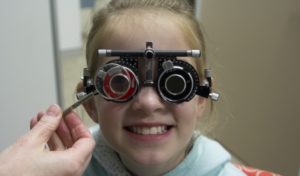10 Easy Facts About Adult Strabismus Explained
Table of ContentsThe Best Strategy To Use For AmblyopiaAn Unbiased View of Emergency Eye ProblemsOur Adult & Paediatric Eye Surgery DiariesComprehensive Ophthalmology - TruthsThe 25-Second Trick For Emergency Eye Problems
Eye doctors are clinical physicians who concentrate on the diagnosis and treatment of eye and vision troubles. What is the distinction between an eye doctor and an optometrist, then? What regarding lens? These three types of eye treatment specialists have instead similar-sounding names and also overlapping job descriptions (EYE EXAM). It can be perplexing in the beginning glimpse.They can not give eye exams, create prescriptions, or identify or treat eye problems. Supply eye examinations, vision screening, and prescriptions for glasses or contact lenses.
They can perform eye surgical treatment and give follow-up care. When giving a thorough eye test, an ophthalmologist will certainly assess your vision and also, if needed, locate your eyeglass/contact lens prescription. They will certainly test exactly how your students respond to light, inspect the placement of your eyes, and also make certain the muscular tissues that move your eyes are working properly.
7 Easy Facts About Adult Strabismus Described
Ophthalmologists diagnose as well as treat injuries, infections, illness, as well as conditions of the eye. Therapies can consist of medicine taken by mouth (by mouth) or topically (in the eye), surgery, cryotherapy (freeze therapy), and also chemotherapy (chemical treatment). Ophthalmologists attend medical institution then receive several years of specialty training in the medical as well as surgical treatment of the eye.
As they are the only doctor who can deal with all eye disorders, ophthalmologists see a variety of eye conditions, consisting of: Exactly how frequently should you have an eye examination? What are symptoms that indicate you may have an eye issue that needs to be checked by an optometrist? The American Academy of Ophthalmology recommends: As kids's eyes are expanding and altering quickly, they ought to get a vision testing.
Adults that have healthy and balanced eyes and also exceptional vision must have four thorough eye examinations: one in their 20s, two in their 30s, as well as one at age 40. These checkups may enable the ophthalmologist to catch an eye disease or vision adjustments at an early stage. By the time you discover signs, you may currently have some vision loss.
An Unbiased View of Paediatric Ophthalmology
People that go to a greater threat of eye illness might require to get an eye examination extra often. This can consist of individuals with diabetic issues, hypertension, or a family members background of eye issues. After age 65, your eyes must be examined each to 2 years. No matter of age, individuals that put on get in touches with need to have a complete eye examination every year.
An ophthalmologist is a clinical specialist who specializes in eye treatment. They are accredited to diagnose and also treat conditions that impact the eye. They can additionally carry out routine eye examinations, carry out surgical procedure, and in shape glasses and contact lenses. This write-up explains what ophthalmologists do special info and also the conditions they deal with (ADULT & PAEDIATRIC EYE SURGERY). It also checks out exactly how they differ from various other healthcare experts that specialize in eye and also vision care.
An ophthalmologist can: execute eye examsdiagnose and also treat eye conditions and diseasesperform eye surgeryprescribe and also fit glasses and also get in touch with lenses, According to the American University of Surgeons, they are the only medical care professionals that have actually obtained training to detect and treat all problems that impact an individual's eyes and also vision. To certify as an eye doctor in the USA, a person needs to finish roughly 12 years of education and learning and also training - https://papaly.com/drc4r0l1n3ctt/ah9EH/My-First-Board.
An Unbiased View of Conjunctivitis


An eye doctor may select to finish a fellowship to become a subspecialist in one area of eye wellness. This training prepares them to deal with more particular or intricate problems in different components of the eye or a certain group of individuals. Subspecialists can concentrate on: This concentrates on cataract surgery, corneal transplantation, as well as refractive eye surgery. https://docs.google.com/spreadsheets/d/1wzSUSF9_O3O4p6Ybsl17uPZHlCj6wrhpSoyFO4dW19Y/edit?usp=sharing.: This area concentrates on conditions that affect the retina and also vitreous.
This location concentrates on clinical as well as medical therapy of problems that trigger damage to the optic nerve. This subspecialty concentrates on eye conditions that affect youngsters. This includes discovering exactly how to carry out operations, consisting of eliminating tumors and fixing bony cracks. This area relates to the neurological problems that include visual symptoms.
:max_bytes(150000):strip_icc()/optometrist-vs-ophthalmologist-5094869_final-0d8eca1d944a4b54b1423065ac2e780f.jpg)
Not known Details About Comprehensive Ophthalmology
The eye doctor will certainly ask the person regarding their medical history, including that of relative. They will certainly after that begin testing as well as checking out the eyes. https://href.li/?https://drcarolinecatt.com.au/. This could include: The ophthalmologist will ask an individual to stand 20 feet away from a graph, cover one eye, as well as state what they can see.
This aids the doctor comprehend just how sharp an individual's vision is. Visual area assessments entail an ophthalmologist measuring how much vision a person has in either eye, whether they have any kind of unseen areas or any various other problems that may influence an individual's sight.Tests include: battle visual area testautomated fixed perimetry testkinetic aesthetic field testfrequency doubling perimetryelectroretinography, Amsler grid Way too much stress can damage the optic nerve and also in some cases cause glaucoma.
There are different kinds of tonometry, including: The eye doctor first numbs the eyes prior to touching the front of them with a portable tool that shines blue. This approach is extra exact than other methods, such as non-contact tonometry. This examination makes use of a puff of air to establish the pressure. This method might be less exact, it does not call for the use of numbing decreases.